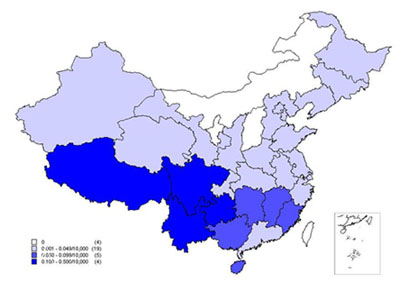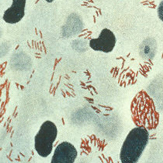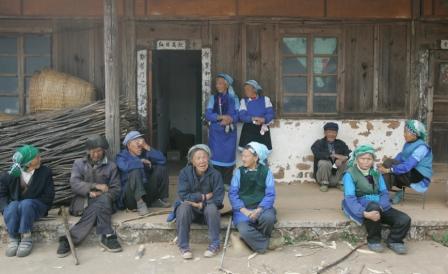Leprosy in China
Introduction
Leprosy, also know as Hansen’s disease, is a chronic disease caused Mycobacterium leprae. Mycobacterium leprae was discovered in 1873 by Aramauer Hansen and was identified as the first bacterium to cause a human disease. Leprosy dates back to biblical times, with the first recording of leprosy in 600 BC. There are even accounts of leprosy cases in the oldest human civilizations of Egypt, India, and China. (6) Leprosy has been a global disease, affecting every continent at one time or another. It has been a pressing issue, not only in the health sphere, but also in the social sphere as leprosy is highly stigmatized. Even to this day, leprosy is present. With the availability of antibiotics and vaccinations, the number of reported cases has dramatically decreased. However, the disease is still very well present. As of 2006, the World Health Organization reported 219,826 cases. (6) Leprosy has made a significant impact in China. Much progress has been made to alleviate the problem leprosy poses and progress is continuing to be made to eliminate the disease.
Description of Leprosy
Leprosy is an infection of the skin, peripheral nerves, mucous membranes of the respiratory tract, and eyes. Leprosy is a slowly developing disease, commonly resulting in deformities, skin lesions, and permanent nerve damage. It may also lead to the loss of limbs and blindness. (7) Because of the seriousness of this disease, much research has been done to target the microbe behind the disease, Mycobacterium leprae. M. leprae is spread in the respiratory tract and accumulates in body extremities. The bacterium infects Schwann cells of the peripheral nervous system. The infected Schwann cells can no longer produce myelin and as a result, nerves are damaged and there is sensory loss. (6)
The Progression of the Disease
Most people have strong enough immune responses to the disease and can resist infection by Mycobacterium leprae. People who are not able to resist the infection begin to show signs of leprosy. This first stage is called indeterminate leprosy. Indeterminate leprosy is characterized for the appearance of small hypopigmented skin macules with some sensory loss around the lesion. In almost all instances of indeterminate leprosy, the disease heals on its own. In other cases, patients progress into a more serious form of leprosy. Indeterminate leprosy can progress into polar lepromatous leprosy (LL), which is more widespread than the former. Lesions in LL are more variable in size and are symmetrical in shape. Skin lesions are found on parts of the body that have a lower temperature, which is a result of M. leprae's preference for cooler temperatures. Symptoms begin to appear in the nasal mucosa, eyes, wrists, knees, elbows, and ankles. In addition, sensory loss worsens. Polar tuberculoid leprosy (TT) is the localized form of the disease. One or more enlarged skin lesions, with anesthesia, are characteristic of TT. The skin lesions are usually near a peripheral nerve. Borderline leprosy (BT) is the median between LL and TT. During this phase, an individual can progress to TT or can revert to LL. Damage to the peripheral nerves is greater, lesions are greater, and there are surrounding, less-defined, lesions around the bigger lesions during BT. (4)
Symptoms
Due to the fact that leprosy is a slowly developing disease, symptoms may take awhile to appear. Symptoms of leprosy include skin lesions, enlarged peripheral nerves, and sensory loss.
Depending on a person’s immune system and response to bacterial infection, leprosy can take on many forms. Severe cases are due to a weak response of the immune system to the infection, as opposed to milder cases in which immune responses are more effective. (4) Milder cases can be cured, but can also worsen into a more serious form of leprosy. If left untreated, leprosy can lead to the crippling of hands and to the loss of fingers and toes. (7)
There are two types of leprosy, each having characteristic symptoms. Tuberculoid leprosy is the milder form, while lepromatous leprosy is the more serious form. A common symptoms of tuberculoid leprosy is small red patches of skin, with a slight loss of sensation in that area. Patients may experience pain, muscle weakness, dry and stiff skin, loss of fingers and toes, eye problems, and enlarged nerves. Patients diagnosed with the more serious form, lepromatous leprosy, may have symmetrical skin rashes on their face, ears, wrists, elbows, knees, or buttocks. Other side effects of lepromatous leprosy include thick skin on the face, thinning of eyebrows and eyelashes, nasal problems, laryngitis, lymph node swelling, gynecomastia, and scarring of the testes. (7)
As daunting as these symptoms may appear, it is important to recognize that these symptoms can be avoided if the disease is treated early on.
Treatment
Leprosy is curable. If treated in early stages, permanent damage can be avoided. Antibiotics are available and are very effective to target the bacterium causing the disease. Since the discovery of Mycobacterium leprae in 1873, thorough research on the microbe was done to come up with a solution. Finally, in the 1940’s, treatment for the disease was found in the form of the dapsone drug. However, within a span of twenty years, Mycobacterium leprae developed a resistance to the drug and this resistance quickly spread. In 1981, a breakthrough was made when the World Health Organization (WHO) enacted multidrug therapy, or MDT, which consists of the drugs dapsone, rifampicin, and clofazimine.MDT was successful in killing the pathogen and it is still very effective. It has now become accepted as the cure to leprosy. Since 1995, MDT has been made available and has been distributed for free by WHO. (6)
Description of the microbe
Mycobacterium leprae was first observed in unstained wet mounts of tissue fluid from lepromas of patients.Hansen discovered that Mycobacterium leprae is a gram-positive, acid-fast, obligate intracellular pathogen. (1) It can infect many cells in vivo such as epithelial cells, muscle cells, and Schwann cells. In addition, it can also infect macrophages. These invasions and destructions by Mycobacterium leprae are responsible for many of the clinical manifestations seen in leprosy such as bacterial progression, immunological responses of the host, peripheral nerve damage, and preventable secondary deformities following nerve damage. (4)
Cell walls
The cell walls of Mycobacterium leprae is a complex network of lipid, protein molecules, peptidoglycan, and carbohydrate. (11) Unlike other mycobacteria, peptidoglycan of Mycobacterium leprae has the unusual substitution of glycine for alanine in the tetrapeptide. This gives the bacteria a pathogenicity advantage, the resistance to degradation. Arabinogalactan-mycolic acid complex consist of linear arrays of D-arabinose-D-galactose with appendages of D-arabinose extending laterally is covalently linked to the peptidoglycan. This complex forms a major amphipathic region external to the peptidoglycan and constitutes about 70% of the cell wall mass. A heightened resistance to degradation by host enzymes is suggested by the lack of the more common L-isomer of arabinose in the cell walls. Pheolic glycolipid I (PGL-1), a cell wall-associated glycolipid molecules of Mycobacterium leprae, is species specific and immunogenic. This antigen exists as a relatively high concentration in purified bacteria and Mycobacterium leprae infected tissues. PGL-1 could serve as a virulence factor in Mycobacterium leprae to provide the critical maintenance of the parasitic relationship between the parasite and the host. (4) The lipoarabinomannan molecules along with the PGL-1 stimulate a strong humoral response that is maximal in patients at the lepromatous pole of the disease. (11)
Transmission of disease
The mode of transmission for Mycobacterium leprae still remains unclear today. However, it appears that having prolonged contact with an infected person is necessary for transmission. Most people who become infected have had extended contact with people who are already infected. Although Mycobacterium leprae primarily affects humans, there have been some cases where animals have also been affected. However, there is no sufficient evidence that transmission can occur from animal to human and vice versa. (4) The result of a study evaluating Mycobacterium leprae in the unbroken skin and nasal secretions of multibacillary leprosy patients and their contacts shows that both skin and nasal epithelia of untreated multibacillary leprosy patients contribute to the shedding of Mycobacterium leprae into the environment. Through both the nasal mucosa and exposed surfaces of skin, contacts of untreated multibacillary cases are at risk for contact with Mycobacterium leprae. (6)
Why Leprosy is a Problem in China
Leprosy was well known and recognized in the oldest civilizations of China, Egypt and India. Until several decades ago, China was among a number of countries that still have many cases of Leprosy disease. Historically, leprosy was greatly feared because of its visible disfigurement and disability, was incurable, and it was believed to be highly contagious. China had been suffered from Leprosy since at least two thousand years ago. The discovery of treatments and drugs such as Dapsone, Rifampicin, and Clofazimine has relieved sufferers at early stage from permanent damages of the skin, nerves, limbs, and eyes. Leprosy prevalence rate was peaked during 1960s, more than 2 per 10,000 populations, but the rate decreased annually to 0.05 per 10,000 populations in 1998. Currently, the prevalence of Leprosy in China is lower than 1 in 100000; However, stigma and prejudice about the disease and patients who affected before, and the uneven distribution occurrences in the country still cause problems in China.
Throughout history, leprosy has been feared and misunderstood, and has resulted in significant stigma and isolation of those who are afflicted. It was thought to be a hereditary disease, a curse, or punishment from the gods. For that reason, there were many misconceptions of leprosy, even stigma and discrimination. China among other countries has created special colonies for people with leprosy called “leper colonies” which are located on islands or in remote location in order to ensure quarantine. There were not many articles addressing the problems of leprosy colonies in recent years.
Due to the deep rooted social stigma and prejudice of Leprosy, patients and their families try to hide or not to admit that the disease resides in their households while sufferers do not show obvious symptoms. This social phenomenon causes an early stage of disease which is definitely curable, turning into an incurable disease or at least into the one that leaves permanent marks on patients. Patients who either carry now or used to, will also be eventually abandoned from their families as well as their villages. Abandoned patients are left with one choice to join the “lepers’ villages”, concentrated in mountain areas in Southwest of China. Once forsaken, even though cured, they hardly have any chance of rejoining the society and the community outside of their “lepers’ villages”.
Stigma and prejudice still exist among affected patients in China. For that reason, one of the serious problems that still arise for leprosy patient in China is due to discrimination which leads to the decrease in health workers working at leprosy colonies and a shortage of medical materials, the health care quality of these people was neglected. Another problem is that many colonies are established in isolated areas, making transportation very difficult. Note that not all leprosy patients reside in the leper colonies. There are a number of reported leprosy diseases still arising in the general population in China. Due to the discrimination and lack of leprosy knowledge and skills among the health workers, many leprosy patients in China did not get an early diagnosis to start the treatment. For the reason that measuring the accurate level of infection and the incidence of Leprosy is impossible, the epidemiology of the disease itself is still a problem in China. This problem becomes more difficult and complicated by the unwillingness and reluctance of the patients seeking help to cure the disease under the influence of social stigma.
What is being done to address this problem
A leprosy control program was initiated during the 1950s by the Ministry of Heath in China. The Ministry of Heath and the National Centre for STD and Leprosy Control also initiated the National Leprosy Recording and Reporting System, which is a database to monitor all leprosy patients in the People’s Republic of China and the epidemic trend of the disease. From the 1950s to 1980s, China’s main focus was to control the infectious sources of leprosy. After the infectious sources of leprosy were controlled, the next step was to eliminate the disease and rehabilitate those affected.
Mass surveys were given in communities and schools to educate the public about the symptoms of leprosy. The survey found that the peak of the disease was during the 1960s, however, after 1970, it decreased annually with the help of multidrug therapy coverage. By 1998, leprosy was well controlled in parts of China, and the prevalence was 0.05 per 10,000 population. Although leprosy is very well controlled in certain areas of China, it not fully eliminated. Leprosy is still present in about 10% of the country where communities are economically poor with low health care.
In recent years, WHO has been trying to sustain the control over the disease with leprosy awareness campaigns and integrating leprosy services into general health services. This will decrease the leprosy burden as well as make leprosy services available for newly detected patients.
In the next 5 years, China’s Ministry of Health plans to identify a minimum of 8,000 new leprosy cases, as well as eliminate the disease in areas such as Anhui, Qinghai, Chongging, Guangdon, and Shaanxi by 2010. So far, the government has been able to provide free health treatment for 500,000 patients. According to statistics, there are still 6,000 leprosy patients in the country, with an estimated increase of 1,600 annually.
Although the disease itself has declined, there is still a huge social stigma against people with leprosy due to the public’s lack of awareness. Although about 95 to 99 percent of the people are naturally immune to leprosy, in China, leprosy is still classified as a third degree infectious disease, which is the same as the flu. A ban was placed in against foreign leprosy sufferers and their relatives entering China. This ban was not lifted until July 25, 2008 during the Olympic games.
What could be done to improve the situation
Although China has been successful in controlling this disease in the 1980s and with the help of the World Health Organization (WHO) making the MDT treatment available free of charge to all patients worldwide in 1995, there’s still an issue of stigma and discrimination among the leprosy sufferers (1). Historically, leprosy was greatly feared because of its visible disfigurement and disability, was incurable, and it was believed to be highly contagious. Due to the lack of awareness, the discrimination has lead to the decrease in health workers working at leprosy colonies and a shortage of medical materials, the health care quality of these people was neglected.
In order to improve this situation, treatment of leprosy needs to be fully integrated into general health services. By WHO standards, the current figures mean the disease is effectively eradicated in China. However, new cases are closely associated with poverty. The worst affected provinces are Yunnan, Guizhou, Sichuan and Tibet. Within these, in 1998, 54 counties failed to meet the eradication criteria as defined by WHO (3). The People’s Republic of China has acknowledged this situation and is now taking the proper steps on improving the problem that they’re facing today. According to Mr. Wand Longde, Vice-Minister of Ministry of Health (MOH), the central government has allocated a certain amount of fund for leprosy control. Also the national government plans to invest 220 million Yuan for launching: (2)
- A national leprosy village/hospital repairing project which focuses on improving the living condition services of medical and rehabilitation care through building new & easy to access leprosy hospitals
- Renovate old facilities in isolated colonies.
- They are also carrying out leprosy education campaigns to improve the awareness of leprosy in local health care, hospitals, and communities in the isolated regions. (2)
Although leprosy sufferers and their families continue to suffer discrimination, China Government Organization along with Non-Government Organization (NGO) has shown its support in improving the life of leprosy sufferers and is taking another step forward in eradicating the stigma by improving the awareness among the people of China. The process will be a slow, but surely it is moving in the right direction.
Summary
Leprosy is a chronic disease caused by a bacillus, Mycobacterium leprae. M. leprae is a very slow developing disease. They multiply very slowly which the symptoms can take as long as 20 years to appear. A symptom of Leprosy mainly affects the skin and nerves. If a person leaves it untreated, there can be progressive and permanent damage to the skin, nerves, limbs and eyes. But luckily, Leprosy is a very curable disease and if treated early patients can be cured within a few months. One of the main organizations that focus on improving and curing this disease is the World Health Organization (WHO). They recommend A Multidrug Therapy (MDT) which is consists of three drugs: dapsone, rigampicin, and clogazimine. These three drugs work together to kill the pathogen and is known to be a very effective cure for the patients.
References
(1) Ashworth, T.G. “Tropical pathology”. Spezielle pathologische Anatomie. (1995) 8.8: 295
(7) “Leprosy Elimination”. World Health Organization. 2009
(8) "Leprosy Symptoms." Clinaero, Inc., 26 Aug. 2008
(14) Yang, Lihe. “Curable disease, incurable prejudice.” HANDA. The Ma Haide Foundation. Jan. 2000
Edited by Angela Nguyen, Khanh Nguyen, Nathan Ly, Renee Kim, and Sung Hong, students of Rachel Larsen




